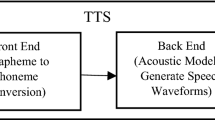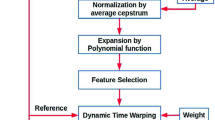Abstract
The authors present new results in solving problems of concatenative segment synthesis of voice information with prosody and vocal utterance, computer modeling of human voice signals based on joint models of human voice source and vocal tract, and speech signal preprocessing for automated documenting systems. The experiments show the efficiency of the proposed approaches.
Similar content being viewed by others
References
T. K. Vintsyuk, Analysis, Recognition, and Interpretation of Voice Signals [in Russian], Naukova Dumka, Kyiv (1987).
B. M. Lobanov and L. I. Tsirul’nik, Computer Synthesis and Speech Cloning [in Russian], Byelorus. Nauka, Minsk (2008).
Yu. G. Krivonos, Yu. V. Krak, and N. N. Shatkovskii, “Structure, properties, characteristics of objects and elements of speech synthesis,” Komp. Matematika, No. 1. 61–69 (2006).
T. Dutoit and H. Leich, “MBR-PSOLA: Text-to-speech synthesis based on an MBE resynthesis of segments database,” Speech Communication, No. 13, 435–440 (1993).
H. Fujisaki, “Prosody, models and spontaneous speech,” in: Computing Prosody, Springer-Verlag, New York (1996), pp. 27–42.
Yu. V. Krak and I. O. Stelya, “Numerical modeling of vocal cords by a two-mass model,” Zh. Obchysl. Prykl. Matem., No. 94, 55–60 (2007).
K. Ishizaka and J. L. Flanagan, “Synthesis of voiced sounds from a two-mass model of vocal cords,” Bell System Techn. J., 51, No. 6, 1233–1268 (1972).
Yu. G. Krivonos, Yu. V. Krak, and I. O. Stelya, “Direct and inverse problems of modeling the human vocal apparatus,” Dop. NANU, No. 10, 44–47 (2011).
B. J. Forbes, E. R. Pike, and D. B. Sharp, “The acoustical Klein–Gordon equation: The wave-mechanical step and barrier potential functions,” J. Acous. Soc. Amer., 114, No. 3, 1291–1302 (2003).
Yu. V. Krak, A. I. Kulyas, and A. S. Zagvazdin, “Determining the modifications of the speaker in a speech signal,” in: Proc. Intern. Sci.-Tehn. Conf. AI-2010, Katsiveli, Crimea, 20–24 Sept. 2010, IPShI Nauka i Osvita, Donetsk (2010), pp. 197–201.
Yu. G. Krivonos, Yu. V. Krak, A. V. Barmak, and A. S. Zagvazdin, “Information system of the distributed computer documenting of speech phonograms of meetings,” Upravl. Sistemy i Mashiny, No. 3, 46–52 (2008).
Author information
Authors and Affiliations
Corresponding author
Additional information
Translated from Kibernetika i Sistemnyi Analiz, No. 4, July–August, 2013, pp. 120–129.
Rights and permissions
About this article
Cite this article
Krak, I.V., Kryvonos, I.G. & Kulias, A.I. Applied aspects of the synthesis and analysis of voice information. Cybern Syst Anal 49, 589–596 (2013). https://doi.org/10.1007/s10559-013-9545-9
Received:
Published:
Issue Date:
DOI: https://doi.org/10.1007/s10559-013-9545-9




